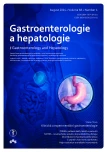Celiac disease – body mass index in patients upon diagnosis and the effect of a gluten-free diet
Authors:
B. Pekárek 1; B. Pekárková 2; J. Hromec 3; Ľ. Jurgoš 4
Authors‘ workplace:
Oddelenie gastroenterológie a endoskopie, Endoskopické poliklinické oddelenie, Národný Onkologický Ústav, Bratislava
1; Gastroenterologická ambulancia GEA s. r. o., Trnava
2; Interná klinika, FZSP TU a FN Trnava
3; Gastroenetrologická ambulancia, FNsP Kramáre, Bratislava
4
Published in:
Gastroent Hepatol 2014; 68(4): 319-324
Category:
Clinical and Experimental Gastroenterology: Original Article
Overview
A significant portion of patients with celiac disease do not suffer with developed symptoms of malabsorption syndrome. So far, only a few studies have focused on the body mass index (BMI) in patients with celiac disease and of the impact of a gluten-free diet. The only known effective treatment for celiac disease is a gluten-free diet, and therefore since 2005 certain basic prescription gluten-free products have been available in Slovak pharmacies and subsidised by the government.
Aims and methods:
The main focus was to assess the number of overweight or obese patients diagnosed with CD and to assess how a gluten-free diet affects BMI, because anticipated weight gain could negatively affect the future morbidity of overweight or obese patients. With a view to the implementation of a partial cover of prescription gluten-free foods by health insurance, we tried to assess the benefits of such a measure. The survey was made as a retrospective evaluation of 153 patients with histologically proven celiac disease. It was supplemented with a single question regarding the assessment of the impact of prescription gluten-free foods.
Results:
We confirmed that only a relatively small portion of patients (21.8%) had a BMI at the level of malnutrition and quite a significant portion (14.5%) suffered from being overweight or obese. A statistically significant increase in BMI was only confirmed in the case of patients with initially low or normal BMI, not in the case of overweight or obese patients. The effect of prescription and partial cover of gluten-free foods was positively assessed not only by the patients with a completely gluten-free diet (92.9%) but also by a significant number of patients not adhering to a totally gluten-free diet (80%). We compared adherence to a gluten-free diet in the group diagnosed before the implication of health insurance coverage of gluten-free foods, and the group of patients diagnosed while this option was available. However, there was no statistically significant difference between these two groups (80.1 vs 88.1%) of patients within our statistical sample.
Key words:
celiac disease – body mass index – gluten-free diet
The authors declare they have no potential conflicts of interest concerning drugs, products, or services used in the study.
The Editorial Board declares that the manuscript met the ICMJE „uniform requirements“ for biomedical papers.
Submitted:
29. 6. 2014
Accepted:
31. 7. 2014
Sources
1. Prokopová L. Celiakie – závažné onemocnění. Vnitř Lék 2003; 49(6): 474–481.
2. Tack GJ, Verbeek WH, Schreurs MW et al. The spectrum of celiac disease: epidemiology, clinical aspects and treatment. Nat Rev Gastroenterol Hepatol 2010; 7(4): 204–213. doi: 10.1038/nrgastro.2010.23.
3. Rubio-Tapia A, Hill ID, Kelly CP et al. ACG clinical guidelines: diagnosis and management of celiac disease. Am J Gastroenterol 2013; 108(5): 656–676. doi: 10.1038/ajg.2013.79.
4. Dickey W, Kearney N. Overweight in celiac disease: prevalence, clinical characteristics, and effect of a gluten-free diet. Am J Gastroenterol 2006; 101(10): 2356–2359.
5. Cheng J, Brar PS, Lee AR et al. Body mass index in celiac disease: beneficial effect of a gluten-free diet. J Clin Gastroenterol 2010; 44(4): 267–271. doi: 10.1097/MCG.0b013e3181b7ed58.
6. Kabbani TA, Goldberg A, Kelly CP et al. Body mass index and the risk of obesity in coeliac disease treated with the gluten-free diet. Aliment Pharmacol Ther 2012; 35(6): 723–729. doi: 10.1111/j.1365-2036.2012.05001.x.
7. Ministerstvo zdravotníctva SR. Zoznam kategorizovaných dietetických potravín 1. 7. 2014–30. 9. 2014. Dostupné z: http://www.health.gov.sk/Clanok?zkdp201407.
8. Bai J, Zeballos E, Fried M et al. Celiac disease. WGO-OMGE Practice Guidelines. World Gastroenterology News 2005; 10 (2 Suppl): S1–S8.
9. Green PH, Stavropoulos SN, Panagi SG et al. Characteristics of adult celiac disease in the USA: results of a national survey. Am J Gastroenterol 2001; 96(1): 126–131.
10. Ukkola A, Mäki M, Kurppa K et al. Changes in body mass index on a gluten-free diet in coeliac disease: a nationwide study. Eur J Intern Med 2012; 23(4): 384–388. doi: 10.1016/j.ejim.2011.12.012.
11. Olén O, Montgomery SM, Marcus C et al. Coeliac disease and body mass index: a study of two Swedish general population-based registers. Scand J Gastroenterol 2009; 44(10): 1198–1206. doi: 10.1080/00365520903132013.
12. Health at a Glance: Europe 2012. OUCD Publishing 2012. Available from: http://ec.europa.eu/health/reports/docs/health_glance_2012_en.pdf.
Labels
Paediatric gastroenterology Gastroenterology and hepatology SurgeryArticle was published in
Gastroenterology and Hepatology

2014 Issue 4
Most read in this issue
- Efficiency and safety of silymarine in patients with chronic liver diseases – multicenter, prospective, open clinical trial IMHOTEP
- High-resolution anorectal manometry – update in the diagnosis of anorectal disorders
- Diverticular disease
- New development in the treatment of acute and chronic diarrhea in the Czech Republic – Tammex family and Tammex family plus
